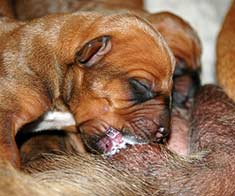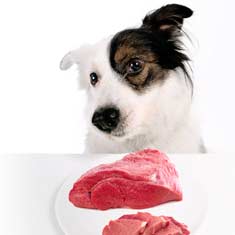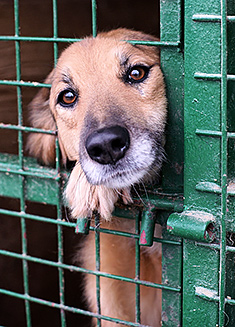Top Ten Questions about Dog Pregnancy and Newborn Puppy Care
1. How can I tell if my dog is pregnant?
After about 15 days, your dog’s nipples will become enlarged and darker, and the fur around the nipples will begin to thin out. The mama dog may lose interest in food after about 3 weeks, as she experiences the canine version of morning sickness. By about the end of the first month, you will be able to hear heartbeats with a stethoscope and will be able to feel walnut-sized fetuses in the dog’s tummy. As the pregnancy continues, you will be able to feel the puppies squirming inside the mama’s tummy. Your dog’s nipples will become swollen, and she may become restless, pacing the house looking for a place to give birth.
2. How long does a dog pregnancy last?
A dog may give birth anywhere from 54 to 72 days after conception. The average is 62 days. At about 54 days, you will begin taking your dog’s temperature rectally twice a day. When her temperature drops a few degrees (to about 98), she will likely go into labor within the next 24 hours. Another sign of impending delivery is a milky discharge from the dog’s nipples, or a clear discharge from the dog’s vagina.
3. How should I feed my pregnant dog?
During the first month of pregnancy, continue your dog’s normal feeding routine. After that, increase the amount of food you are giving her by 25% each week. For example, if you normally feed 1 cup twice a day, you will feed 1-1/4 cups during week 5, 1-1/2 cups during week 6, 1-3/4 cups during week 7, and 2 cups during week 8. After the first four weeks, you will begin feeding puppy food rather than dog food, to provide the proper nutrients and calories your mama dog needs for her growing brood. Finally, you may need to divide the food into several small meals rather than just feeding her twice a day, as she will likely become less interested in food as the babies take up more and more room in her belly.
4. How much exercise does a pregnant dog need?
The more the better! Walking and running condition the dog’s muscles, including the important uterine muscles she will need to expel her newborn puppies. As the pregnancy progresses, your dog will become more tired and will lose interest in running. However, you should still take her for several short walks each day to keep her muscles strong for the coming puppy birth.
5. What is a whelping box?
A whelping box or pen is the area where your pregnant dog will give birth. Many people use a playpen with one side folded down. Others block off an area of a room that is not carpeted. The area should have sides high enough so that the puppies cannot get out, but low enough that the mama can step over without banging up her nipples. Also, there should be a ledge running around the inside so that the puppies have an area they can slide under if the mama rolls over in her sleep, preventing them from being crushed. The pen should be lined, either with newspapers or old towels. Finally, you must consider where to place the whelping box. It should be in a quiet place where the dog is comfortable, and where you can control the temperature to help keep the newborn puppies warm.
6. Does my dog need any help to give birth?
Many dogs can birth their puppies with little or no help from you. However, some dogs will need assistance, and you can improve the chances that all of the puppies will live by staying close by during the delivery. If a puppy gets stuck in the birth canal, you will need to gently pull him out by hooking your index fingers either over the shoulders or behind the hips and pulling downward. If the mama dog doesn’t begin tending to the puppy within 2 minutes, you will need to break the amniotic sac and rub the puppy with a clean, rough towel to stimulate breathing. Clear the mucus out of the puppy’s eyes, nose, and mouth. Finally, if mama doesn’t chew off the puppy’s umbilical cord, you should tie it off with dental floss, then cut the cord and dip the tip in iodine to prevent infection.
7. When will my puppies open their eyes?
Most puppies open their eyes about two weeks after birth. If your puppy hasn’t opened his eyes by three weeks of age, consult your veterinarian. Also, if your puppy’s eyes become swollen or begin to leak pus, you will need to treat him for an eye infection.
8. My mama dog can’t bring down enough milk to feed her puppies. What should I do?
You can feed your puppies by hand if the mama can’t or won’t feed them enough to make them gain weight. A good substitute formula can be made by mixing together a 13 oz. can of evaporated milk, an equal amount of distilled water, 4 oz. of plain yogurt, 4 egg yolks, and 1 tablespoon of liquid vitamins. Feed 2 – 3 ccs of formula every 2 – 3 hours if your puppy is under 7 oz. Over that weight, feed 1 cc per ounce of body weight, every four hours. If your mama dog is bringing down any milk at all, make sure each of the puppies gets at least some of it. Mother’s milk provides important antibodies to keep your puppies healthy until they can manufacture their own antibodies.
9. My puppy won’t pee or poop. What should I do?
First, check for dehydration. If you pinch the skin on the top of your dog’s neck, it should immediately flatten back down to its original position when you let go. If it remains tented, you will need to force-feed the puppy some Pedialyte to get him hydrated, which should make him pee. If the puppy is not dehydrated and is very young, he may just need some stimulation, which he would normally get by his mother’s licking his tummy and anus. To substitute for his mother’s tongue, use a warm, moist cotton ball to gently stroke his tummy and around his anus several times a day. This should stimulate him to pee each time and to poop about every third time.
10. How can I tell if one of the puppies is sick?
At the most basic, you should watch for one puppy that is acting differently than the others. A sick puppy may be limp, resembling a dishrag. He may vomit or have diarrhea, and his tongue will be cool to the touch. A mama dog may refuse to interact with a sick puppy. This is Mother Nature’s way of ensuring that only the fittest of the species survive. After taking the puppy to the vet, you may need to take over the care of this puppy to nurse him back to health.
Doggies Den: Latest Articles
 Homemade Thanksgiving Treats for Your Dog
Homemade Thanksgiving Treats for Your Dog
NUTRITION We all want to include our dogs in our holiday celebrations, but hopefully, you're aware that sharing table scraps with your dog isn't always the best idea.
 Keeping Your Dog Safe during the Summer Months
Keeping Your Dog Safe during the Summer Months
HEALTH Summer is coming on fast, so it’s time to plan how you will keep your dog safe and healthy through the lazy, carefree, warm days.
 Vaccination Time Again-Keeping Your Puppy Healthy
Vaccination Time Again-Keeping Your Puppy Healthy
DOG HEALTH So you have your new puppy picked out. There are quite a few shots, treatments and examinations that will keep the newest member of your family healthy.
 Canine Thanksgiving Feast
Canine Thanksgiving Feast
NUTRITION With the wide variety of food at Thanksgiving dinner, chances are you'll want to give your dog something special, too. If you're contemplating what to feed your dog for the holiday, here is a guide to a great Canine Thanksgiving Feast.
 Dog Walking Tips Every Owner Should Know
Dog Walking Tips Every Owner Should Know
DOG FUN Walking your dog is not only crucial to keeping him healthy and happy, it strengthens the bond between your canine friend and his caregiver. There are a lot of obstacles out there. Don’t forget these simple tips to keep your walk fun and safe in the outside world.
 The Benefits of Physiotherapy for your Dog
The Benefits of Physiotherapy for your Dog
HEALTH The same techniques that physiotherapists use to treat a variety of injuries and conditions in humans have been adapted to suit animals with great success. Family pets, show dogs, and working dogs can all benefit greatly from physiotherapy. Dogs whose activities involve a lot of agility are especially susceptible to the types of problems that physiotherapy can address.
 The Decision- Adding a Dog to Your Family
The Decision- Adding a Dog to Your Family
FIRST TIME OWNERSBringing a dog into your family is a decision where many people don’t realize it’s magnitude until after they have the dog. There are a number of things that you need to research before you decide to purchase a dog, and it starts right in your own home.
 Bringing Your Dog Into Your New Baby's Life
Bringing Your Dog Into Your New Baby's Life
HEALTH Many believe that a dog and a new baby cannot happily coexist, so therefore the dog has to go. This is not necessarily the case.  A new baby does not mean you have to abandon your dog.

Doggies Den:
Most Popular Articles

Dog Pregnancy Symptoms
HEALTHIf you suspect your dog might be pregnant, check out part one in this series on pregnant dogs, where we cover pregnant dog symptoms.

Dog Birth
HEALTHIn the third article of our dog pregnancy series, we look at the wonderful, but messy, process of bringing newborn puppies into the world.

Indoor Dog Potties
DOG PRODUCTSIt's been a long day at work. You were so busy, you didn't even take time to eat a sandwich, let alone run home to let your dog out. You're on your way home, knowing the poor dog is crossing his or her legs by now, when your car breaks down, delaying you even further. Can't somebody make this easier?

Your Dog’s Digestive System
PHYSIOLOGYEver wonder why your dog eats so fast? Or why he eats gross things? Or why he gets sick to his stomach? Or why his waste stinks so bad? Some of these things are normal, some are not.

Canine Respiratory System
BREATHINGThe basic function of your dog's respiratory system is to bring oxygen in to and remove carbon dioxide from the body. Knowing the symptoms of respiratory diseases can help you help your stay healthy.

Shelter Dog Adoption Tips for Success
ADOPTION Are you intimidated by the prospect of "rescuing" a dog from a shelter? One reason that you may be wary of adopting a dog from a shelter is not knowing how to choose. Adopting a dog from a shelter can be a rewarding process, if you're prepared to do a reasonable amount of research.

Canine Urinary Tract Infections
SYMPTOMS AND TREATMENTDoes your dog seem to be having trouble relieving his or her bladder? Learn how to recognize the signs of urinary tract infections and how to treat them before they spread.

What to do for Dog Diarrhea
SYMPTOMS AND REMEDIESIf you have dogs in your house for any length of time, you have likely experienced at least one bout of dog diarrhea. Beyond the pain in the tuckus involved in cleaning up the mess, you should know what causes diarrhea, and when it's important to see the vet.

What to do for a Dog Bite
DOG BEHAVIOR Getting bitten by a dog can be scary, and you may be tempted to run around in circles for a while, trying to figure out what to do. Here's our guide to help you manage the situation.

Top Ten Tips for Living with a Senior Dog
DOG HEALTH Bringing home a new puppy is so exciting, but it doesn’t take all that long for your exuberant puppy to grow into a senior dog who may have special needs. Here are the doggies.com top ten tips for taking care of your companion who has been with you through so much.
